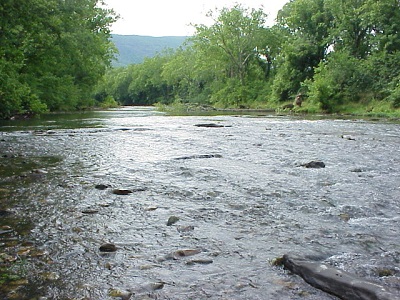 Mercury from Waynesboro factory taints fish, other wildlife in South Fork Shenandoah, its tributary
Mercury from Waynesboro factory taints fish, other wildlife in South Fork Shenandoah, its tributary
Chemical giant DuPont has agreed to pay more than $50 million to deal with mercury contamination of two Virginia rivers caused by the company’s one-time operations in Waynesboro, federal and state officials announced Thursday.
The Justice and Interior departments and the Commonwealth of Virginia filed a proposed consent decree in U.S. District Court in Harrisonburg spelling out terms reached with the multinational company based in Wilmington, DE. The largest settlement of its kind in Virginia comes after decades of studies, litigation and negotiations over how to resolve extensive contamination.
Under the deal, DuPont would pay $42.3 million to federal and state agencies to fund cleanup and recreational projects on the South Fork Shenandoah River and one of its tributaries, the South River. The company also agreed to pay up to $10 million toward the renovation of a state fish hatchery at Front Royal, VA.
Gov. Terry McAuliffe credited the deal to collaboration between state and federal agencies. But he also praised the work of a scientific advisory committee and acknowledged DuPont’s “willingness to come to the table and make this happen.”
In addition to announcing the settlement, federal and state officials released a draft restoration plan laying out a series of steps to help restore the river and wildlife habitat while also improving public lands and enhancing recreation in the watershed. Authorities will take public comment on the plan until Jan. 30, 2017.
The financial settlement is intended not only to help restore the river, but to compensate the public for the loss of recreational opportunities from the contamination.
From 1929 until 1977, DuPont manufactured acetate fibers at a 177-acre Waynesboro factory, as well as several other products, including nylon. The plant is now owned and operated by another company, but DuPont still owns the land.
Mercury, a neurotoxin that was used in the manufacturing process until 1950, was released into the South River in the 1930s and 1940s, and contaminated more than 100 miles of river and floodplain in the two rivers watershed. It was detected in fish in the 1970s, prompting authorities to issue fish consumption advisories warning anglers about consuming too much of certain types of fish caught in the river.
Mercury continues to seep into the river from contaminated soils at the site, and consumption advisories remain in effect as monitoring data collected over the last 20 years indicates that mercury levels remain stable, with no clear decreases over time. The contamination affected not just fish, but mussels, migratory songbirds and amphibians, according to the draft restoration plan.
In 2005, DuPont signed a consent decree with the Natural Resources Defense Council and the Virginia Chapter of the Sierra Club, which had sued over the contamination. The company agreed then to a six-year study of the river to determine the extent of the problem, come up with a remediation plan and fund abatement measures.
Through the new settlement, authorities hope to reduce contamination levels at least some by curbing erosion of mercury-tainted soils along the river banks, a major source of the toxic chemical getting into fish and other aquatic animals. Among the measures proposed are streamside plantings and stormwater pond improvements to reduce runoff. The agencies also are weighing projects to propagate and restore mussels to improve water quality and stabilize sediment, to restore migratory songbird habitat and to expand and enhance recreational access to the river. The hatchery renovations would enable improved production of warm-water fish such as smallmouth bass.
“Fish, wildlife, land and waters, as well as the city of Waynesboro and other communities affected by decades of mercury release, will benefit from natural resource projects improving water and stream quality, protecting and restoring wildlife habitat and increasing river access for recreation,” Wendi Weber, Northeast regional director of the US. Fish and Wildlife Service, said in a statement.
Virginia Attorney General Mark Herring added: “This settlement will allow us to protect and enhance lands throughout the Shenandoah Valley and improve the quality of water for wildlife, anglers, paddlers and others who use these waterways for recreation.”
Mike Liberati, South River project director for the DuPont Corporate Remediation Group, noted in a statement that the company has been working with state and federal officials to assess the impacts of the mercury contamination on the river. He said that in addition to the payments agreed upon in the settlement, DuPont has invested millions of dollars in local educational and cultural activities and has underwritten the work of the South River Science Team, which is run by the Virginia Department of Environmental Quality to evaluate river conditions.
The company expects to finish work on the first phase of its remediation in February, according to Liberati. Mercury-tainted soil in a portion of riverbank in Constitution Park in Waynesboro is being excavated, hauled away and replaced with clean dirt, while other areas with lower levels of contamination are being stabilized with erosion controls.
The settlement is subject to approval by the court. Officials said they plan to review any comments they receive before finalizing the draft restoration plan. It is available for review here. The proposed consent decree is posted here.
A public meeting has been scheduled to provide highlights of the draft restoration plan and answer questions. It will be from 6 p.m. to 8:30 p.m. on Jan. 10 at the Waynesboro Public Library, 600 S. Wayne Avenue, Waynesboro, VA 22980.

